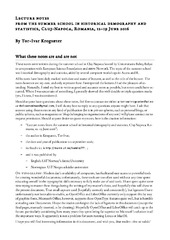| dc.contributor.advisor | Neerland Soleim, Marianne | |
| dc.contributor.author | Bökenbrink, Katharina | |
| dc.date.accessioned | 2023-06-16T05:35:48Z | |
| dc.date.available | 2023-06-16T05:35:48Z | |
| dc.date.issued | 2023-05-13 | en |
| dc.description.abstract | This thesis is primarily concerned with the representation of women with sexual transmitted infections (STI) who were incarcerated in internment camps (Polizeihaftlager) during and right after the German occupation of Norway. There is little previous research on this specific prisoner category, the available sources are scarce and those who are available differ in its consistency and type. The overall goal of this thesis is to give an insight into the life of these prisoners and the discrimination and treatment they received, through the analysis of language and terms used to describe them. Since there are no sources by the prisoners with STIs themselves, the thesis must rely on others representation of them, which comes with the problem that these representations blend description with discrimination. Therefore, must discrimination and stigma because of infection be a central topic that will be explored along the lines of language, representation, and discourse analysis. This thesis aims as well to illustrate how this discrimination manifests itself through language and how it, in this case, is mainly affecting women. To implement a gender perspective in this specific case the thesis relies on the concept of intersectionality, a concept that aims to describe the intersections of discrimination. The incarceration of women with sexual transmitted infections during and after the occupation has many cross points with other research topics within the broader topic of the Second World War. It relates to the general incarceration of enemies of the national socialist system, sexual morality and policies related to that, especially the persecution of the so-called “tyskertøsene” (“German Girls”), the women who had romantic or sexual relations to Germans during the occupation and the stigma related to these relationships. | en_US |
| dc.identifier.uri | https://hdl.handle.net/10037/29414 | |
| dc.language.iso | eng | en_US |
| dc.publisher | UiT Norges arktiske universitet | no |
| dc.publisher | UiT The Arctic University of Norway | en |
| dc.rights.holder | Copyright 2023 The Author(s) | |
| dc.rights.uri | https://creativecommons.org/licenses/by-nc-sa/4.0 | en_US |
| dc.rights | Attribution-NonCommercial-ShareAlike 4.0 International (CC BY-NC-SA 4.0) | en_US |
| dc.subject.courseID | HIS-3900 | |
| dc.subject | VDP::Humaniora: 000::Historie: 070::Kvinnehistorie: 073 | en_US |
| dc.subject | VDP::Humanities: 000::History: 070::Women's history: 073 | en_US |
| dc.subject | VDP::Humaniora: 000::Historie: 070::Sosialhistorie: 072 | en_US |
| dc.subject | VDP::Humanities: 000::History: 070::Social history: 072 | en_US |
| dc.subject | VDP::Humaniora: 000::Historie: 070::Samtidshistorie (etter 1945): 084 | en_US |
| dc.subject | VDP::Humanities: 000::History: 070::Contemporary history (after 1945): 084 | en_US |
| dc.title | “Danger to Self or Others?” Internment of women with sexually transmitted infections during and after World War II in Norway. | en_US |
| dc.type | Mastergradsoppgave | no |
| dc.type | Master thesis | en |


 English
English norsk
norsk



